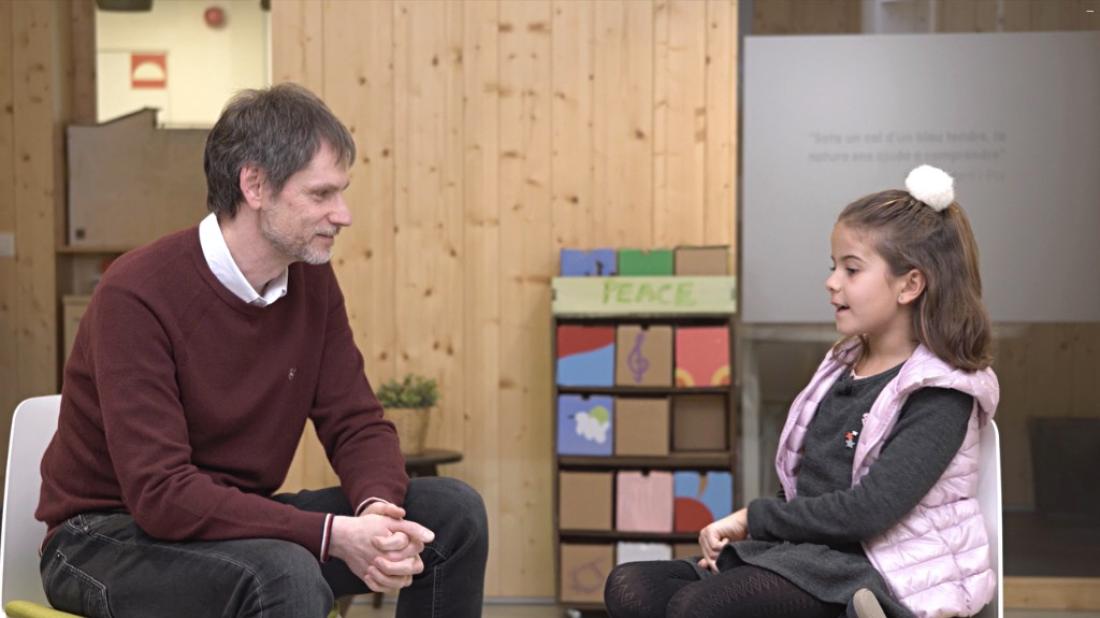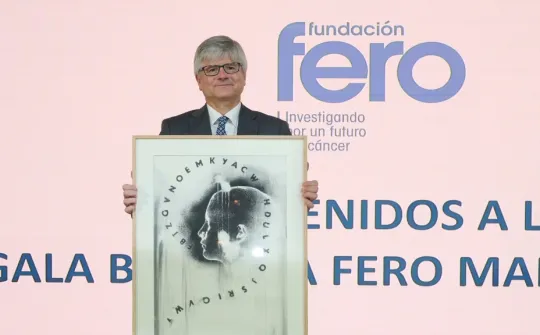
Four years after this disease affected the entire world, Dr Juan José García, Head of the Pediatrics Department, explains how Kids Corona has helped foster a better understanding of how COVID-19 affects infants and pregnant women.
Almost four years have passed since we first started hearing about COVID-19. Since the start of the pandemic, the SJD Barcelona Children's Hospital has made use of the Kids Corona platform to do research into how coronavirus affected infants and pregnant women. This investigative effort has allowed for a better understanding of the SARS-CoV-2 virus and of how to develop more efficient treatments.
Dr Juan José García, Head of the Pediatrics Department at the SJD Barcelona Children’s Hospital, also explains how this platform has provided data about the disease to research teams all over the world.
Where did the idea for Kids Corona first come from?
We saw that children were almost unaffected by COVID-19: it started out as a disease that only really seriously affected adults. With SARS-CoV-2, it was the opposite of what normally happens with respiratory diseases. They usually have greater impact on children, who become the main point of infection for other parts of the population. The question that led to setting up Kids Corona was “Could children be naturally protected from this illness?”. From there, we started to ask all of the questions we wanted answers to.
What were those questions, and what conclusions were you able to reach?
The first question we asked was whether children could get COVID-19. Then we also asked whether they could transmit the disease, and how it manifested in them, and then why they usually presented much milder symptoms. We asked all these questions because perhaps they could give us answers that would allow adults to better face SARS-CoV-2.
We did several studies to answer our questions, and then we created a platform where both wider society and researchers could access the data and samples, should they wish to carry out further studies. This platform was Kids Corona, which has been source of trustworthy information ever since. In fact, we have had around 75,000 visits. We also launched a participation campaign where 5,000 people were able to analyse their symptoms.
From here, we also collected over 1,500 samples from patients with the virus, and some of them—almost 25%—have been used by researchers at other centres to work on their own research projects. These professionals have also been able to access the data from our other studies. Being able to share information about COVID-19 was one of the key aspects of Kids Corona.
What do you have to say about the whole team that has worked on Kids Corona?
Our aim with Kids Corona was only possible thanks to the collaborative efforts of countless researchers, clinicians and support staff from several departments and units in the SJD Barcelona Children's Hospital and the Foundation. They decided to join forces to carry out a hugely ambitious project, with the aim of providing answers to society in a time of great uncertainty. Our institution felt it had a moral obligation to contribute to the search for and development of knowledge.
Have you have worked alongside other institutions outside of the healthcare sector?
We launched this project thanks to donations from the Stavros Niarchos Foundation (SNF), the Bank of Santander, and other private donors, to whom we are immensely grateful.
More in-depth now, how did you carry out your research to find out infection incidence rates among children?
To answer the question of whether kids could become infected with COVID-19, we organised key groups during lockdown who would go to homes of those infected with the virus, and we saw that a similar percentage of children were infected as the adults were. However, we also saw that most children were asymptomatic, or had only very mild symptoms.
The second question was whether they could transmit the virus. With viruses like the flu, children easily spread the disease, becoming infected at school and then bringing it home to their family. We designed a study into summer camps that opened in 2020, because these places were where children usually went. These establishments reopened their doors with a lot of security measures—bubbles, hand-washing, using masks, open-air activities, etc. With all of that in mind, we observed whether children who became infected would transmit the virus to their groups and family members.
With the summer camps study, we were able to establish that children could, in fact, transmit the virus, though the percentage of children who contracted it was lower than that of adults. For example, at the time, the transmission rate (R factor) was at 2, and children had a rate of 0.3. We also observed that, in the summer camps where rules were stricter, transmission rates were much lower than those with more relaxed policies.
And can we apply these conclusions to other areas with both children and adults, such as in the family?
We came to similar conclusions in the family unit. In the home, children were often not the main source of transmission. The transmission rate among children was 0.46, and in adults, 2.6.
We also looked at transmission when playing sport, for a period of more than one year. We carried out this part of the project with the help of the FC Barcelona formative categories. What we found is that playing sport did not increase risk of infection, and the infections that did occur were very similar to those in other areas of society. In indoor sports, we found higher transmission rates than those played in open air.
In the first few months of the pandemic, what kind of symptoms did children have?
The last area we had to look into was why children presented such a mild version of the virus. One of our first hypotheses was that perhaps children developed an immune response that afforded them better protection against the virus. We were able to confirm this. It was also found that the most severe immune reactions occurred in adults—these reactions are what cause more severe symptoms—and not so much among children.
Researchers at Kids Corona saw that type 1 interferons—a protein that is produced in response to a viral infection—play a key role in children presenting a milder response. However, in adults, this type 1 interferon response is not as intense, and this leads to adults experiencing worse symptoms.
And what proportion of children have experienced severe cases of COVID-19?
The percentage of children who developed severe symptoms was very low: we are talking one case in every 3,000 or 5,000 infections. When we found a patient fitting this profile, they presented what is known as Multisystem Inflammatory Syndrome in Children (MISC). This is a very rare manifestation of COVID-19 that appears between two and four weeks after infection, and that is very similar to Kawasaki disease. This means they have a very similar physiopathology, for example, with regard to alpha interferon, one of the key cytokines involved in both diseases.
The impact of COVID-19 on pregnant women was also one of the key research objectives of Kids Corona: what were the main conclusions drawn about how this group is impacted by the virus?
Those who are pregnant are one of the most vulnerable groups, because their immune defences may be lower than the rest of the population. After monitoring thousands of different pregnant women, we found that if they became infected during the first trimester, they would have very mild symptoms. However, if they became infected later on, despite mostly having mild symptoms of COVID-19, around 5% could suffer from more severe symptoms of SARS-CoV-2. We also found that having the virus did not increase the risk of miscarriage nor other concerning complications.
Could the work you have done with Kids Corona be used to develop treatments for COVID-19 that benefit the entire population?
As soon as we identified certain exaggerated immune response patterns that were involved in severe cases of the disease, we were able to create more effective treatments to help avoid severe symptoms.
You have also done some important work on the effects of lockdown on mental health. What have you found?
Confinement caused many emotional disorders among children and adolescents, such as eating disorders, anxiety, increased risk of suicide, etc. The lockdowns may have been a trigger or a contributing element, but this is a concerning factor that, after three years, we are beginning to see how we can tackle it.
Now, with the return to normality, the mental health repercussions of COVID-19 have continued to be monitored and resources are being put in place. In many cases, there was already a baseline. Many problems appeared when lockdown ended, and many of them are perhaps not only a consequence of COVID-19. However, it is certain that the virus fuelled them.
In the four years since COVID-19 first appeared we’ve seen many different variants. What specific symptoms have children and pregnant women presented in particular?
The first variants were the most severe, but less contagious. As the pandemic progressed, milder but more contagious variants appeared. This is the natural progression of infectious diseases: viruses are not interested in killing off the host because the host is their only way of reproducing. So it is normal for more contagious variants to appear that are not strong enough to kill the infected person, because then they can spread. In the pediatric group, at the beginning we saw almost no infections. Now we do, but mild ones.
At the time, there was a lot of talk about the impact of SARS-CoV-2, especially when it came to child-centric places such as schools or summer camps. What answers did your research provide in this respect?
The more enclosed a space is and the more people there are there, the higher the risk of transmission. Medical professionals always try to encourage activities in open air—sports or daily physical activity—, which greatly reduces the risk of infection. You do not need to go to hiking in the mountains every day, as that is not possible for everyone, but going to the park works fine. The importance of open-air spaces is something that administrations and councils have to keep in mind. Basically, it is yet another factor in favour of more comprehensive healthcare for children and the rest of society – or, as it is known nowadays, planetary health. At the end of the day, everything has consequences.



